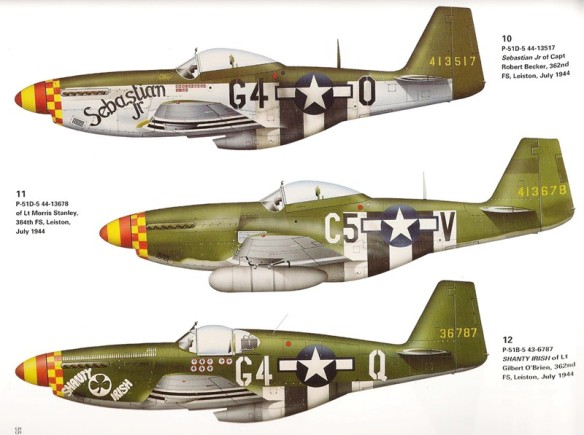The 357th Fighter Group was an air combat unit of the United States Army Air Forces during the Second World War. The 357th operated P-51 Mustang aircraft as part of the U.S. Eighth Air Force and its members were known unofficially as “The Yoxford Boys” after a village near their base. (Group tradition holds that the name was the invention of Lord Haw Haw in a broadcast greeting the night of its arrival at RAF Leiston.) Its victory totals in air-to-air combat are the most of any P-51 group in the Eighth Air Force and third among all groups fighting in Europe.
The 357th flew 313 combat missions between 11 February 1944 and 25 April 1945. It is officially credited by the U.S. Air Force with having destroyed 595.5 German airplanes in the air and 106.5 on the ground. The 357th existed as a USAAF unit only during World War II and its immediate aftermath. Its history, lineage and honors were bestowed on an Ohio Air National Guard group, but the Ohio ANG considers itself a direct descendant of the 357th FG.
Since its first use in the theater as escort on combat missions in December 1943, the P-51 had rapidly demonstrated its unique suitability for this purpose. Operations during January, in which the limited number of P-51’s then available were able to give target support to the bombers on all their important missions, further confirmed the feeling that this plane was the answer to the long-range escort problem. Since January, the range of the P-51 had been extended. Without external tanks that aircraft could escort to a point approximately 475 miles from base, a distance roughly equal to the maximum escort range of the P-47 equipped with two 108-gallon auxiliary wing tanks. In March it was demonstrated that the P-51 with two 75-gallon wing tanks could escort to a point about 650 miles from base, with two 108-gallon tanks it could reach the then unheard of escort range of 850 miles. Long-range escort, which of recent months had been recognized by all as the bottleneck of the daylight strategic bombing campaign, was now a reality. More of the P-51’s were needed, especially in the Fifteenth Air Force, which had to go through bitter enemy opposition during February without them; but they were operating by March in sufficient numbers to protect some of the Eighth’s largest daylight bomber formations even over the most distant targets.
At the end of March 1944 there were operating in the Eighth Air Force, and in addition the Ninth’s 354th Group, three groups the 4th, 355th, and 357th with 140 P-51 completely operational.
A coordinated air campaign against central European targets now ensued. Doolittle assumed command of the Eighth Air Force at a time when its fortunes were on the rise. Because of increased production and accelerated training programs in the United States, at the end of January 1944 he had twice the number of B-17s and B-24s and bomber crews that Eaker had commanded at the end of October of the previous year. Far more important, however, was the growing number of P-51 Mustangs. Even though the Ninth Air Force, a tactical organization, received the first group of P-51s to reach the United Kingdom, these aircraft escorted strategic bombers of the Eighth Air Force on missions deep into Germany. The new design gave Doolittle what Eaker had lacked a fast, maneuverable fighter with jettisonable fuel tanks and a new internal tank behind the cockpit that could protect bombers over Berlin and beyond.
The appointment of General Spaatz to direct the American strategic air forces in Europe demonstrated that daylight precision bombing would continue despite the reverses suffered in October 1943. Although Eaker’s British associates regretted the departure of a personable and undoubtedly competent commander, Spaatz soon came to exert greater influence in Anglo-American councils than his American predecessor or such British airmen as Harris or Air Chief Marshal Sir Trafford Leigh-Mallory, the Commander in Chief, Allied Expeditionary Air Forces. The influence wielded by Spaatz resulted from his harmonious and militarily successful relationship with Eisenhower, who, as the war in Europe neared an end, ranked Spaatz as one of his two best generals, and also from the fact that Arnold selected him and held him in high regard.
The P-51 contributed immensely to the revival under Spaatz of daylight bombing offensive. The escort fighters had their short-comings, however. The P-51 had poor cockpit ventilation and an uncomfortable seat that could combine to cause fatigue on a long flight; and the oil for the superchargers in the P-38 could congeal in the extreme cold, leaving the Allison engines gasping for air at a time when the pilot needed maximum power. Even when their aircraft functioned perfectly, tired or overly aggressive pilots could push their fighters beyond performance limits. Capt. John T. Godfrey, credited with destroying sixteen and one-third German aircraft, attempted too violent a maneuver in the thin air at high altitude and, according to an eyewitness, tumbled end over end before regaining control of his P-47. Combat six miles above the soil of Germany demanded a finely tuned machine and the full attention of an alert and well trained pilot.
As the American fighters increased in number and improved in performance, Spaatz attacked Germany with aircraft from the Fifteenth Air Force based in Italy and Doolittle’s Eighth Air Force, now stronger and better equipped than it had been under Eaker. The renewed offensive was governed by a February 1944 modification of the POINTBLANK Directive, which gave overriding priority to the destruction of the German fighter force.
